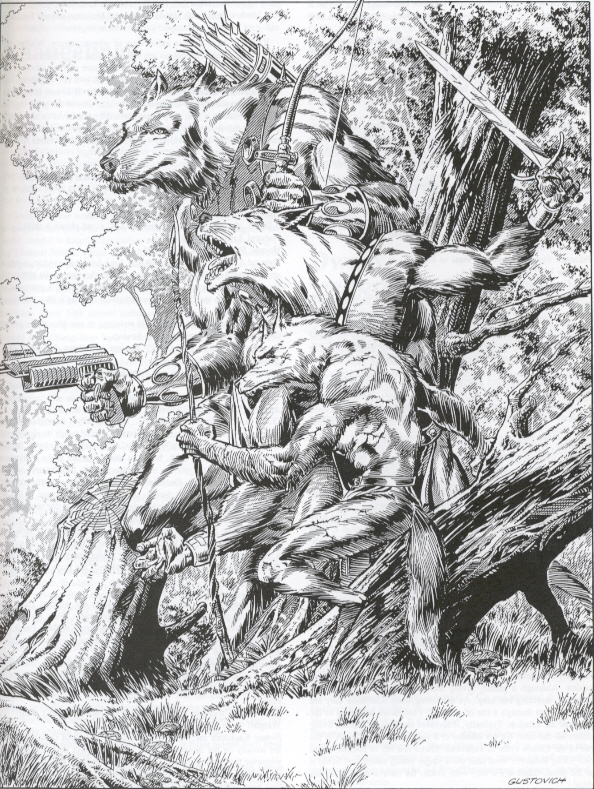(Following from yesterday's post.)
In this imagined project of cleaning up the material from Palladium's fantasy game into a proper Advanced Dungeons & Dragons 1st Edition campaign, the big hurdle will come from the rules.
Kevin Siembieda's ruleset for The Palladium Fantasy Role-Playing Game is just similar enough to those that played any D&D edition or derivative to get started, but what is a bother is how he went about his takes on Alignment, Classes, Races, and Magic.
This post is not going read like the conversion notes on a wallet-sized reference card of Imperial-to-Metric (or vice versa) unit conversions. This is going to focus on the stuff that you as Referee need to know now- and what can be split off for closer scrutiny at a later step.
Alignment
Toss Palladium's arrangement complete and use AD&D1e. The alignments map to AD&D1e on a LG-CE axis; Principled is Lawful Good, Diabolic is Chaotic Evil, True Neutral is in a liminal space around where Anarchist is, and you can figure the rest out from there.
Classes
Men-At-Arms maps easily, though you may want Unearthed Arcana and Oriental Adventures on hand.
Mercenary Fighter, Soldier, Gladiator, Sailor, Pirate, and Longbowman (and many others) are all Fighters. Ranger is a 1:1 crossover, as is Paladin; Knight is Cavalier. Thief and Assassin are obvious, and Thief-Acrobat should be considered as open for players to use. Warrior Monk is Monk or Sohei. Barbarian, due to how UA and OA handle that class, should be kept out save for specific conditions wherein those class restrictions make sense.
Men-Of-Magic is where the difficulty starts. Wizard, Summoner, and Diabolist (a mis-named Class) are all Magic-Users; the latter two's magic forms should be converted as either variations of existing spells or as magic item formulae. Illusionist maps over as-is. Mind Mage is Psionics. Warlock (also misnamed) and Witch are more difficult and require a more nuanced consideration, as they are actually priest variants.
Men-Of-Faith starts easy enough, as both Priest of Light and Priest of Darknesss are Clerics. Druid, despite not being identical, should be treated as such. Where things get weird is the Shaman, which is actually a gimped NPC-only spell-caster in AD&D1e; I would rather roll them into the Druid class or maybe use OA1e's Shugenja for them. The aforementioned Warlock and Witch are both Classes whose supernatural power is directly tied to a supernatural patron; the former is an elemental theme and the latter serves demons- you can use Wu-Jen and Cleric as rough conversions, but I think these two classes in particular need something more to do them right.
There are a lot of other Classes that really are not PC-viable in PFRPG- ditch them, as they are NPCs.
Races
The easy part are Dwarves, Elves, Gnomes, and Men. Halflings aren't a thing. Changlings, Ogres, Troglodytes, Trolls, Orcs, Goblins, and Kobolds are not open for PCs to play- simple as. That leaves the Wolfen, Coyles, and Kankoran. (Respectively: Wolf-Men, Coyote-Men, Fox-Men.)

Yes, a RIFTS pic, but it shows all three. Wolfen biggest, Coyles mid, Kankoran small.
This matters because the Wolfen lead one of the biggest global powers: The Wolfen Empire. (Just imagine Peak Rome, but run by Wolfen.) They need, at the least, a Monster Manual entry (as do Coyles and Kankoran); maybe they could be player-accessible races also, but the Wolfen Empire relies a lot on non-Wolfen clients and allies- one of which is their primary source of heavy cavalry.
If you want to do this yourself, you'll need to have a copy of the PFRPG rulebook and a copy of Monsters & Animals or the RIFTS Conversion Book on hand to handle the details.
Magic
Which is also necessary for the magic stuff.
No, not because it's difficult, but because there's so much published and you'll want to sort which PFRPG thing goes where. Some will be added to existing AD&D1e spells. Some will be variations on those spells. Some will be a new class or variant of magic item. (This is where Ward Magic, what Diabolists do, falls; they're variations of scrolls by default, but can also be put down as more permanent enchantments. Circle Magic, what Summoners do, are just new/variant Magic-User spells that do a lot of pet-wrangling.)
As for the items--magic widgets--most of those transfer over easy enough. The rest are akin to Stormbringer: bad enough to merit being consider a NPC in itself.
Oh, and Psionics is a thing in PFRPG games; get used to the Psionics appendix, and you may want to bust out Mind Mage as a variant Magic-User class.
Monsters
Kevin went wild with making these up, and making his own spin on better-known ones. Couple this with things like Demon Ships--yes, demons encased in warships; this was decades before Stupid British Toy Company did it--and you'll see that Palladium has plenty of Weird Fiction in it.
So How Long Will This Take?
You have a team. Handle each part step-by-step, splitting the workload to save time, and this should be playable in about a month; this presumes that you're adults doing this as a hobby, so an hour here and there over the usual week doing this instead of watching TV or shitposting on Twitter. This also includes writing your conversions down, cleaning that up, and posting it to your campaign Discord so players know what is and is not allowed as a PC (or for a PC) in the campaign.
At this time, you also want to decide on the usual stuff like how Ability Scores are rolled up and include that in your player-facing campaign brief.
Once this is done, check with your time to see that everyone has the campaign maps and calendar. If you're good to go, it's time to start recruit adventurers and getting your faction players submitting orders.
We'll get to this tomorrow.
No comments:
Post a Comment
Anonymous comments are banned. Pick a name, and "Unknown" (et. al.) doesn't count.